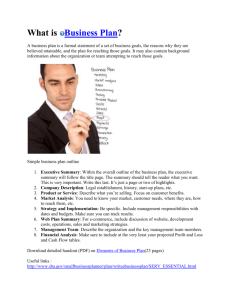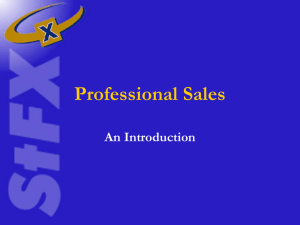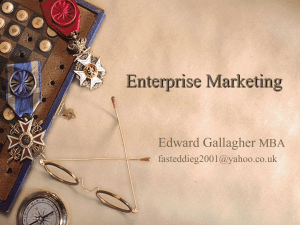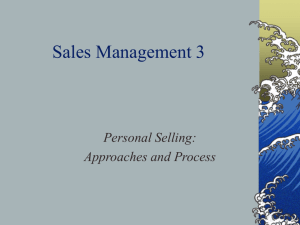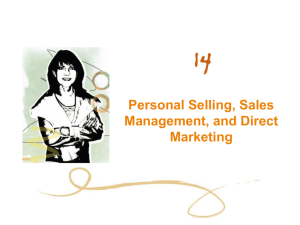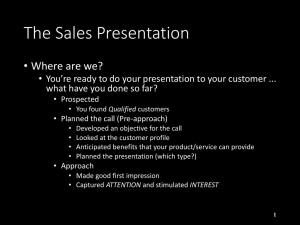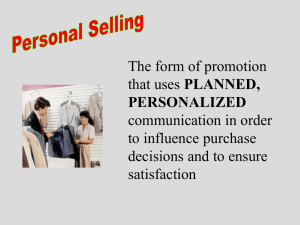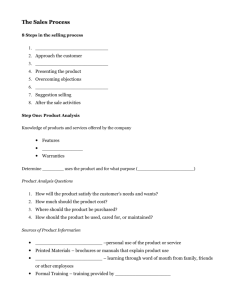.- .
advertisement
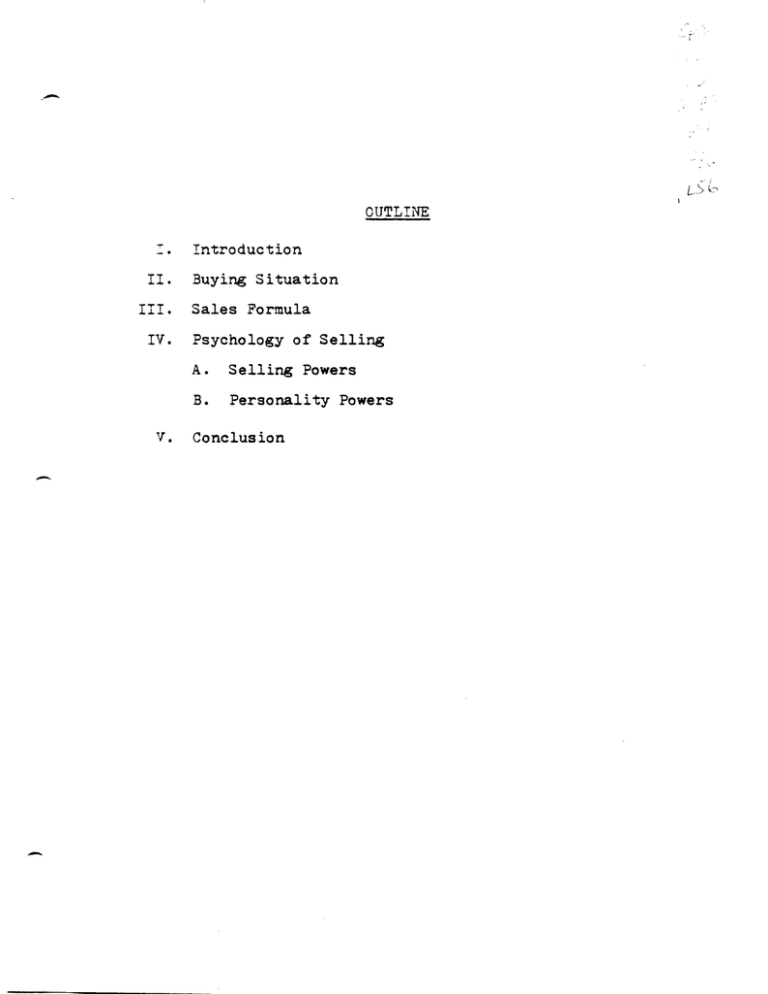
.OUTLINE -. "T' II. III. IV. v. - .- Introduction Buying Situation Sales Formula Psychology of Selling A. Selling Powers B. Personality Powers Conclusion THE SELLING GAMEl An Outline - for ID 499 Spring 1986 presented to Art Martin SCPB Amy C. Lindop )14-80-)077 -ntroduction "Successful salespeople know the basics"l In today's economic and social world, everyone is a salesman in one form or another. Selling has been described as the art of persuasion, putting one over on someone, taking candy from a baby, or the transfer of information and basic need satisfaction. From these phrases, one can see that there is some emotional significance attached to the subject of salesmanship. In the not-too-distant past ~istory of the United States, our economy was based on a production orientation; this meant that manufacturers would make those pro- - ducts that they expected to sell to the consumers, without any real attention devoted to which products the consumers really wanted. ~en ~ith this mindset, the manufacturers' sales- had the responsibility to sell the factory output to any and every market; thus, the concept of the "hard sell" was born. The salesmen had to convince or coerce the buyer into making a buying commitment, which won for the salesmen an unpopular reputation for pushing unwanted products on unwitting buyers. As the standard of living and national income averages rose in the 1950's and 60's, the manufacturers were forced to change from the product orientation to the market orientation. Consumers were becoming more demanding in their product wants, - and because they had the buying power to back up their demands, the manufacturers took notice and started to produce the products consumers wanted in the style and qua~ity desired. This new market orientation caused a drastic change in the way salespeople approached their selling prospects. No longer could they be successful by cowering their quarry into buying unwanted merchandise; salesmen now had to learn how to appeal to the buyer's wants and needs. and to show how a specific product offering could satisfy those needs. All these changes in the evolution of the selling concept have led to a new definition of selling: "To sell is to provide services or goods for money or its equivalent. To engage in selling is to persuade a prospect of the value of a product or service. so that he or she is willing to exchange something of value for it. Consequently, selling is an interdependent human acti vi ty." 2 From this definition. one can see that selling is not restricted only to business situations- it is a part of everyone's daily life. Not only is selling "everyone's business", but it is also something that can be learned and developed in an individual 2 c- 3uying Situation Unlike advertising, personal selling often involves a reversal of communication roles. The salesperson becomes a receiver and the prospect becomes the source. The salesman usually receives a rapid feedback because of the face-to-face nature of the situation. in a further attempt to The sales message can be altered then ~ke the sale. The better a salesperson understands the product or service and the needs and personali- !I of the potential customer, the more effective the sales message will be. In any buying situation, there are five decisions being made in the commitment to buy or not to buy: 1. 2. 3. 4. 5. the the the the the need to be fulfilled product or service to fulfill the need source for the product/service price or value time to buy (now or later) There are also three fears of buying: 1. 2. J. the fear that the product won't do what the salesperson says it will do the fear that the product is not worth the money (or might be obtained at a lower price elsewhere) the fear that other people may not approve of the product or of the purchase decision What do people really buy when they accept an offer from a salesperson? buy benefits. Buyers don't buy products and services- they Benefits are facts translated into human values, features of the product/service translated into what they can ~ to the buyer. It is these benefits that will sell the product to the buyer, if the salesperson presents these benefits clearly and logically in the sales presentation. J Sales Formula The sales formula consists of seven basic stepss 1. 2. J. 4. 5. 6. 7. ~ach Prospecting Pre-Approach Approach Presentation Overcoming Objections Closing the Sale Follow-Up step will be explained individually; however, it should be noted that often some steps will be combined in the interests of practicality and saving the buyer's time in real life situations. Prospecting is the groundwork of the sales formula. In this stage the salesperson must identify the people or firms likely to have an interest in his product or service. Pos- sible sources of prospects are recommendations from current customers, advertising leads, past customers, trade publications, and cold canvassing. The second step is the Pre-Approach, which involves identifying the decision makers or the "right person" responsible for authorizing the commitment to buy. This can save the sales- person valuable time and money because he can present his information to the individual who has the power to make a buying decision for the firm. avoiding any assistants or underlings who may be interested in helping but who have no authority. During the pre-approach, the salesperson also tries to identify the likely needs and benefits matches between the buyer's firm and the company's product offerings. In concluding this step. the complete sales presentation should be planned in the mind 4 - of the salesperson, including possible objections from the buyer. ~an Solid preparation in this stage will benefit the sales- greatly in subsequent steps of the formula. ~he approach involves getting the prospect's attention, making a good impression on the individual, and selling oneself and one's personality to the prospect. At this time, if it is not convenient for the buyer to listen to a presentation, the salesperson should make an appointment to return at a later date. Under no circumstances should the salesperson leave without planning another meeting, because it will assuredly be more difficult to set up an appointment over the phone than in person. Buyers are very pressed for time in their schedules, and it is always easier to "get rid of" a salesperson over the phone than in person. Use this to one's advantage! These t'hree steps lead up to step four, the Sales Presentation. which incorporates all the information gained so far. The presentation should focus on the key selling points or benefits to that specific buyer and company. The main points should be covered, buy not every detail needs to be mentioned. Be prepared to back up the presentation with numbers and figures, but reserve them for their appropriate time. Remember that it is hard for a listener to grasp the meaning of numerical inf'or~·· mation that is presented in passing, therefore, save the numbers for discussion on more specific aspects of the sale. . the presentation 1. 2. 3. 4. 5. should cover the following: Management summary and overview Advantages Financial considerations Implementation/Schedule Contract 5 In general, .- Objections raised by the prospect make up the fifth" step of the formula. The salesperson must anticipate pos- sible objections and have a ready reply for the prospect. Objections should be considered a legitimate part of the sales process, not merely interruptions or unnecessary problems. On the positive side, objections signal to the salesperson that the prospect is at least interested enough to ask a question; these questions also give the salesperson an opportunity to explain further the selling points of his product and to cover any additional information inadvertently left out during the actual presentation. No matter what the buyer's behavior, the salesperson is obligated to use a professional and relaxed manner during all business proceedings. The sixth step is Closing the Sale, one of the most important parts of the selling formula. most salespeople lose The main reason that sales is not because they make poor presentations or cannot handle objections professionally- it is because they don't ask for the sale. Whenever the prospect makes a commitment to buy, the close and order taking process should start; in other words, if the prospect says "yes" after the salesperson says "hello", then scrap the formula. The major drawback to using this formula is that some people feel they must proceed with the rest of the steps, even if the buyer has agreed to buy already. -- Remember, the objective is not to complete the formula but to complete the sale. There are numerous ways to close a sale if the prospect has 6 volunteered to buy the product outright. is a subtle buy?" ~ethod The assumptive close of avoiding asking the question "will you It entails simply asking the buyer if he would like style A or style B, delivery to the factory or to the wholesaler, etc. The assumptive close assumes that the buyer has agreed to buy from the salesperson, without making the prospect say yes or no specifically. Another method of closing the sale is the summary close, wherein the salesperson summarizes the benefits of his product/service and asks for the sale. With this method, the salesperson may withhold special concessions until the end of the process and use them to close (price cuts, free installation, trial orders, etc.). The final step of the selling formula is the follow up. This is the only stage that is continuous in nature; follow up entails checking up on the order to see that it is delivered on time, that the buyer is satisfied with his purchase, and that no strings are left untied. Because most businesses depend on repeat sales for a large portion of their livelihood, the follow up of the salespeople is of significant import. Cul- tivating customer goodwill and maintaining a positive company reputation will have far-reaching effects for the firm that takes the time to do these things through solid follow up. 7 - Selling Powers In personal selling, there are four types of selling powers that the salesperson may possess; depending on the specific situation, certain types of power may be of more use to the salesperson. The four types are the following: expert power, persuasive power, association power, and information power. Expert power signifies a special expertise, skill, or understanding that a person possesses in a specific area. For example, pharmaceutical salespeople possess expert power in the area of the pharmaceuticals they sell: it is not uncommon for the salesperson to know more about certain drugs and diseases than the doctors they call on, but it must be noted that the salesperson's expertise is confined to a concentrated area, not generalized to many areas. Persuasive power is the ability to convince others to change their behavior, even against their better judgement. Hereiri ~ is the crux of what many people feel is the problem with selling: the salesperson tries to get people to do something they do not desire to do. However, some amount of persuasiveness is neces- sary to induce a buyer to listen to a presentation, or consider changing products, or even to secure an appointment time. Association power involves friendship or companionship with another who has influence or power; the association may - be made with a person or a brand name (Halston, Waterford, etc.) • . Information power entails special knowledge or understanding o-r a subject, or of a source of in-rormation on it. For e%8JDple, an individual with the knowledge of how a data base is set up 8 for a certain computer program has information power, even though he may not understand the implications of the data on any specific situation. Personality Powers Based on research over the last sixty years, four basic personality types have been and selling situations. identi~ied in relation to the buying The four types are Bold (B), Expressive (E), Sympathetic (S), and Technical (T). In any communication situation. there will be two personalities interacting; for the most part. they will not be the same types in the buying/selling situation. Thus, one must have a basic understanding of the di~ferences between one's own style and the styles o~ the other individuals with whom one will have to negotiate. The Bold personality is drawn to challenges and enjoys the thrill of a new adventure. The 30ld style needs to dominate and is proficient at making quick decisions and getting quick results. However. this individual is not apt to make long-term plans. and direction for the future can be a problem. wants of ~he Some_ 30ld type are freedom, power, authority, action, and changeJ some needs are the need to learn to listen. to pay attention to details, and to be aware of others. The Expressive personality is stimulated by being around others·and persuading them to take his viewpoint. ~igh E's need to influence others; they are good with people and generate a positive environment. However. werking alone may become a problem for an Expressive. Some wants 9 o~ an E are popularity. influence, acceptance, to be around people, and to persuade. Some needs are time management, objectivity, objectives, atten~ion to details, and control of talking. 'rhe Sympathetic personality tends to be patient and loyal, needing to belong and to serve. are willing to follow. High SiS are hard workers and ~owaver,working just for work's sake and feeling secure in that work may be a problem. Some of the wants for a High S are adjustment time, stability, appreciation, and schedl.lle. Some needs are d~adline&, lead time, attention, and understanding. The last personality is the Technical individual, who tends to be controlled, cautious, and rule oriented. The High T has an orientation toward planning and accuracy, and .tries to reduce the risks of . deci:iion- making by depending on :facts and logic. Some wants o:f a High T are organization, rules, standards, expectations, and little risk. Some needs are to make quicker decisions, to use more power, and to take action. Each personality type will have a dif:ferent style as :far as interacting in a buying situation is concerned. The good salesperson will take the time to discover what type o:f person the prospect is and will tailor his presentation and approach to that personality's likes and dislikes. Obviously it will be more difficult :for opposite types to work together sueessfully, but with some practice and keeping these principles in mind, the attempt to use this information will have positive benefits :for the salesperson. 10 Conclusion Thousands of pages have been written on the subject of selling, salesmanship, the psychology of the sales process, etc. Thousands ~ore will probably be written in the ~uture on new theories of buyer behavior, and on new methods for salespeople to increase their effectiveness. One could probably read them all and still not know exactly what selling is, because the selling process remains largely an area of human interaction and behavior, which has even more written on it than does selling and salesmanship. To be frank, there is no magic involved in being an effective salesman- it is mainly a case of finding the people who need your product, and explaining it to them objectively. If the product is of good quality, and the source company is reputable, and the buyer ~eels that this product has the right combination of benefits and features, then the sale will be made. The salesman ~erely brings all the parts together conveniently and provides the buyer with an opportunity to say yes. In closing, one must share with the reader the basic philosophy behind all American business successes: "He who dies with the most toys wins." 11 References 3aer, Earl E., Salesmanship. r:1cGraw-Hill Book Company, York, NY, 1972. :'lew Brewer, James , Michael Ainsworth, and George Wynne, Power 3elling. Prentice-Hall, Inc., Englewood Cliffs, NJ, 1985. McDaniel, Carl, iviarketing. Harper NY, 1982. - - & Row Publishers, New York, ,- - - Footnotes 1 Baer, Earl E., Salesmanship. McGraw-Hill Book Company, New York, NY. 1972. p. 2 2 Baer, p. 3
